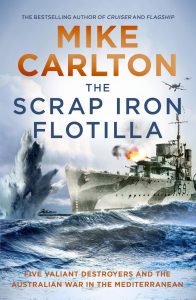At the outbreak of war in 1939, the British asked Australia for help and it was, over time, given willingly and in quantity but one of its earliest contributions was to send, with some misgivings, five destroyers to join the Royal Navy fleet in the Mediterranean.

The five were HMAS Stuart, Vampire, Vendetta, Voyager and Waterhen; they were old, small ships with engines that were on their last legs right from the start. The crews were able to joke about their dilapidated state but Josef Goebbels, when he heard about them, sneeringly labelled them ‘a load of scrap iron’. In the same defiant spirit as the Rats of Tobruk adopted their nom de guerre from the Nazis’ propaganda, the five ships happily and proudly called themselves the Scrap Iron Flotilla.
Scrap iron or not, the flotilla was involved constantly and closely in all the operations of the Mediterranean fleet. They escorted troop and supply convoys, hunted submarines, engaged in bombardment of targets on shore in support of Allied land campaigns and participated in large fleet engagements, notably the Battle of Matapan. They were involved in the rescue of the Australian and allied troops following the withdrawal from Greece and Crete and in the constant, dangerous resupply convoys to the besieged Tobruk.
Their principal enemies were the navies and air forces of Italy and Germany but they also faced extreme weather; icy winds and mountainous seas or filthy sandstorms from North Africa which reduced visibility and fouled every part of the ship. Living conditions on the ships were terrible; cramped and stinking sleeping quarters, inadequate washing facilities and poor and unvarying rations.
Mike Carlton has captured this story in a work which bears all the hallmarks of a detailed, thoroughly researched and scholarly history but is also a narrative of an exciting adventure, a memoir of the thoughts and feelings of many of the participants and a thoughtful analysis of the strategies and decisions affecting the campaign.
The book contains evidence of detailed, meticulous research into the ships and the various specifications of their equipment and weaponry. There is also sound research into the strategies, plans and orders they received and the way in which operations were conducted; there is a good balance between the higher-level objectives and strategies and the operational and tactical involvement of the Australian ships. The author has supplied three maps that are most helpful in understanding the environment and the key places of interest. There is a map of the Mediterranean, a more detailed map of the Eastern Mediterranean where most of the action took place and, very helpfully, a map illustrating the progress of the battles of Cape Matapan and Cape Spada.
Especially interesting, however, is the detailed information the author is able to supply about the people involved. His focus is not just on senior commanders and ship’s captains but also on many of the junior officers, the engineers and the ordinary seamen, stokers and signallers. His extensive use of quotations from diaries, letters and published memoirs provides valuable insights into not just what the crews were doing but into how they felt and how they interpreted and expressed their experience. Perhaps surprisingly, there is also a wealth of biographical information on the Italian and German commanders and pilots against whom the flotilla was fighting. This was presented at the stages of the narrative when they were engaged with one of the Australian ships and provided a view of the battle from both sides. These personal and mostly contemporaneous observations add a welcome richness to the narrative. Further richness is added through the extensive array of photographs showing all the ships as well as many of the key personalities and places of interest.
On the matter of research, it is clear, in fact explicit, from the endnotes and bibliography that a wealth of material has been sourced from Wikipedia. Carlton notes that this is a ‘vast and invaluable resource, although occasionally its facts have to be cross checked’. It is not immediately apparent from the endnotes that cross checking has occurred.
A minor distraction from the main themes is the way in which the author wears his political heart on his sleeve. Carlton is well known as a journalist of the left but it detracts from the scholarly tone, and indeed from the adventure narrative, when, for instance, he describes the Australian Prime Minister, R. G. Menzies, who was visiting the Middle East, in terms dripping with scorn. There are justified criticisms to be made of any and all leaders, and especially in the tumult and uncertainty of war, but these are best made in terms of policies, actions and outcomes without personal animus.
This is a valuable contribution to Australian naval history because of its wide scope, detailed narrative and analysis and the excellent balance of the strategic and the personal. It will be of use to the naval history student and perhaps even more so to the general reader who wishes to have important aspects of Australian history presented in a compelling, interesting and well-informed style.
Reviewed for MHHV by Lieutenant Colonel (R) Michael Buckridge RFD MA MBA Vice-President MHHV
Contact Michael Buckridge about this article.






